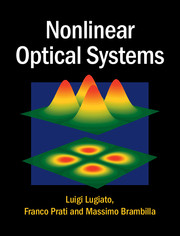Book contents
- Frontmatter
- Dedication
- Contents
- Preface
- Part I Models, propagation, stationary phenomena
- Part II Dynamical Phenomena, Instabilities, Chaos
- 18 Some general aspects in nonlinear dissipative dynamical systems
- 19 Special limits in the single-mode model
- 20 The linear-stability analysis of the Maxwell–Bloch equations
- 21 Adiabatic elimination in the complete Maxwell–Bloch equations
- 22 Dynamical aspects in the laser
- 23 Single-mode and multimode operation in inhomogeneously broadened lasers
- 24 Dynamical aspects in optical bistability
- 25 Self-pulsing in other optical systems
- Part III Transverse optical patterns
- Appendix A The Routh–Hurwitz stability criterion
- Appendix B Calculation of the oscillatory instability boundary
- Appendix C Coefficients of the characteristic equation (20.20)
- Appendix D Derivation of equations (20.27) and (20.28)
- Appendix E Coefficients of equations (20.60) and (20.61)
- Appendix F The exact boundary of the Risken–Nummedal–Graham–Haken instability
- Appendix G Nonlinear analysis of the roll solution
- References
- Index
23 - Single-mode and multimode operation in inhomogeneously broadened lasers
from Part II - Dynamical Phenomena, Instabilities, Chaos
Published online by Cambridge University Press: 05 March 2015
- Frontmatter
- Dedication
- Contents
- Preface
- Part I Models, propagation, stationary phenomena
- Part II Dynamical Phenomena, Instabilities, Chaos
- 18 Some general aspects in nonlinear dissipative dynamical systems
- 19 Special limits in the single-mode model
- 20 The linear-stability analysis of the Maxwell–Bloch equations
- 21 Adiabatic elimination in the complete Maxwell–Bloch equations
- 22 Dynamical aspects in the laser
- 23 Single-mode and multimode operation in inhomogeneously broadened lasers
- 24 Dynamical aspects in optical bistability
- 25 Self-pulsing in other optical systems
- Part III Transverse optical patterns
- Appendix A The Routh–Hurwitz stability criterion
- Appendix B Calculation of the oscillatory instability boundary
- Appendix C Coefficients of the characteristic equation (20.20)
- Appendix D Derivation of equations (20.27) and (20.28)
- Appendix E Coefficients of equations (20.60) and (20.61)
- Appendix F The exact boundary of the Risken–Nummedal–Graham–Haken instability
- Appendix G Nonlinear analysis of the roll solution
- References
- Index
Summary
The instabilities in homogeneously broadened lasers, which we described in the previous chapter, have a paradigmatic importance because they arise in models which allow one to perform the linear-stability analysis in a simple analytic form. The treatment of the corresponding instabilities in the case of in homogeneously broadened lasers is substantially more complex in general. However, it is very interesting because, as we shall see, the instabilities arise in parametric domains that are much more accessible from the experimental viewpoint.
A related issue is that of the possibility of multimodal emission in a laser. It is common knowledge that in order to attain multimode emission it is necessary to have a sort of in homogeneity in the gain medium, because in a completely homogeneous configuration all modes interact with all atoms, and the arising competition among modes implies that only one of them survives.
There are basically two main kinds of in homogeneity, the first is of spatial nature and the other is of spectral nature. The first kind is realized in Fabry–Perot lasers, because different cavity modes interact with atoms at different spatial positions in the cavity thanks to the standing-wave configuration of the field and to the consequent phenomenon of spatial hole- burning (see Section 14.2 and Fig. 14.1). This circumstance is capable of weakening the mode–mode competition and allowing multimode operation. In unidirectional ring lasers, on the other hand, there is an “inhomogeneous” configuration in the case of inhomogeneous broadening, because different groups of atoms have different transition frequencies and therefore interact with different modes thanks to the spectral hole-burning (see Section 15.2 and Fig. 15.3). Again, this weakens the mode–mode competition and allows multimode operation.
However, these are qualitative considerations, and the only reliable and quantitative method to determine the possibility of multimodal operation is the linear-stability analysis of the single-mode stationary solutions.
- Type
- Chapter
- Information
- Nonlinear Optical Systems , pp. 275 - 287Publisher: Cambridge University PressPrint publication year: 2015



